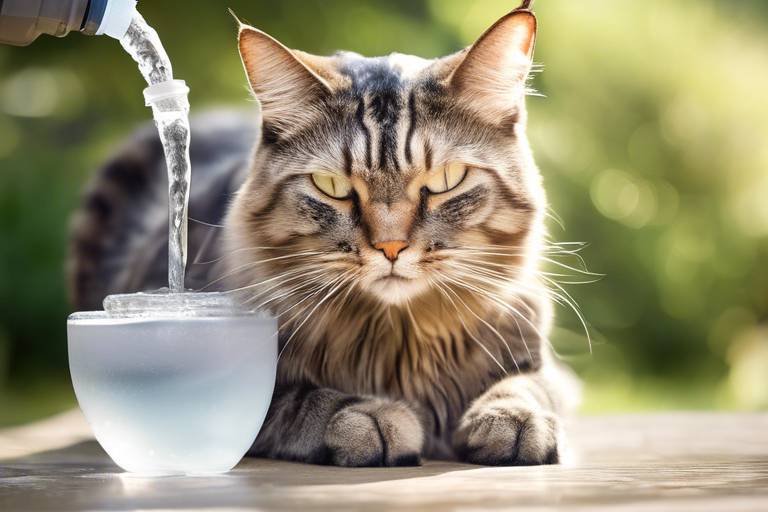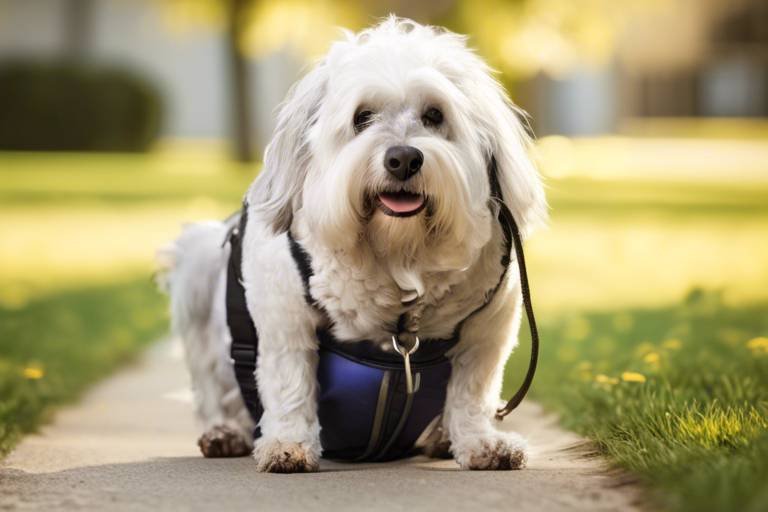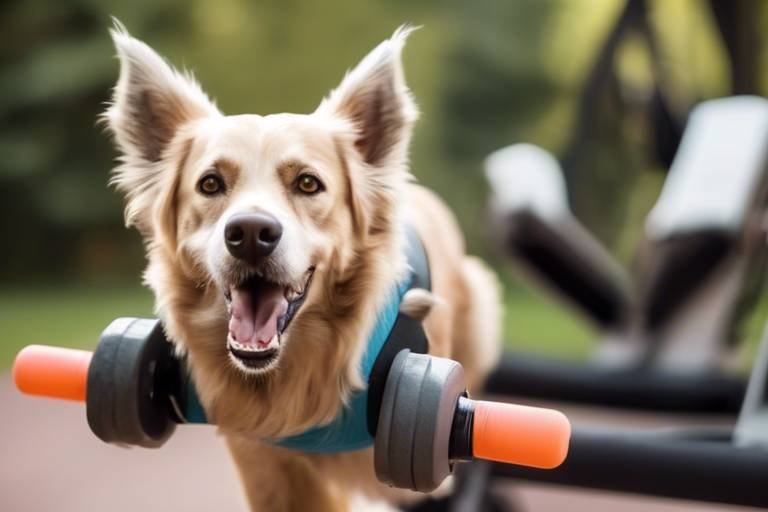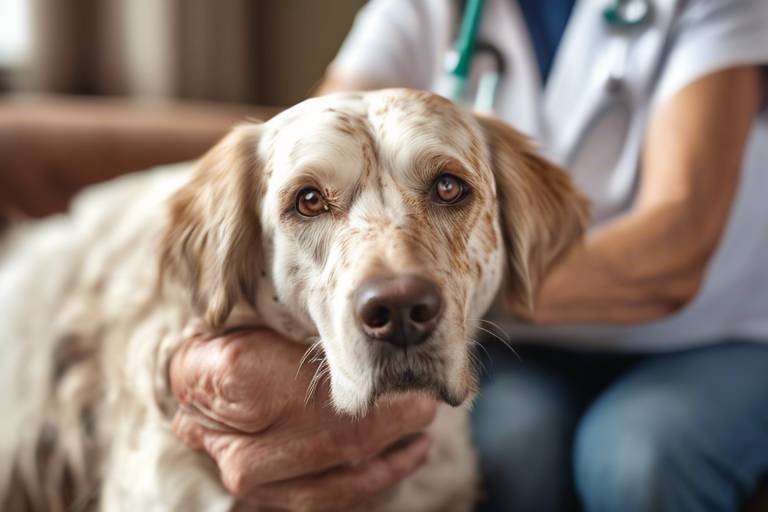Caring for Senior Pets with Mobility Issues
As our beloved furry friends age, they often face a variety of challenges, and one of the most significant issues is mobility. Just like us, pets can experience aches, pains, and stiffness that can limit their ability to move freely. This is especially true for senior pets, who may have spent many years running, jumping, and playing. When they start to slow down, it can be heartbreaking for pet owners. However, there are numerous ways to ensure that our senior pets maintain their quality of life, even when mobility issues arise.
Understanding the unique needs of senior pets with mobility challenges is crucial for any pet owner. These issues can manifest in several ways, including difficulty getting up, reluctance to walk, or even noticeable limping. Recognizing these signs early allows you to take proactive steps to help your furry companion. After all, they depend on us to provide the care they need as they navigate their golden years. It's not just about keeping them comfortable; it's about ensuring they feel loved and valued throughout their lives.
In this article, we will explore essential strategies and tips for providing care to senior pets facing mobility challenges. From understanding the signs of mobility issues to creating a safe home environment and managing pain, we will cover everything you need to know to help your pet live a fulfilling life despite their limitations. Remember, your senior pet may not be as spry as they once were, but with the right care and attention, they can still enjoy their time with you. Let's dive in!
Recognizing the common mobility problems that affect older pets is crucial for effective care. This section discusses the signs and causes of mobility issues in senior animals.
Regular veterinary visits are vital for monitoring the health of senior pets. This section emphasizes how check-ups can help identify mobility issues early and guide treatment options.
Adapting the home to accommodate pets with mobility challenges can enhance their safety and comfort. This section provides practical tips on making your home pet-friendly.
Proper nutrition plays a significant role in managing mobility issues. This section explores dietary adjustments that can support joint health and overall well-being in senior pets.
Physical therapy can significantly improve mobility in senior pets. This section discusses various rehabilitation techniques and exercises that can help enhance their physical capabilities.
Assistive devices can provide support and improve the quality of life for pets with mobility issues. This section reviews various options available for pet owners to consider.
Effective pain management is essential for the comfort of senior pets. This section discusses various pain relief methods and medications that can help alleviate discomfort.
Emotional well-being is just as important as physical health for senior pets. This section highlights ways to provide emotional support and enrich the lives of pets with mobility challenges.
Here are some common questions pet owners have regarding the care of senior pets with mobility issues:
- What are the signs that my senior pet is having mobility issues? Look for signs such as difficulty getting up, reluctance to walk, or changes in behavior.
- How often should I take my senior pet to the vet? Regular check-ups, ideally every six months, can help monitor their health and catch issues early.
- What dietary changes can help my senior pet? Consider diets rich in omega-3 fatty acids and joint supplements to support mobility.
- Are there specific exercises I can do with my senior pet? Gentle stretching and short walks can help maintain muscle tone and flexibility.

Understanding Mobility Issues in Senior Pets
As our furry companions age, they may face a variety of challenges, and one of the most significant is mobility issues. Just like humans, pets experience wear and tear on their bodies over time, which can lead to discomfort and limited movement. It's important to recognize the signs of these mobility problems early on to ensure that our beloved pets receive the proper care they need. Common signs of mobility issues in senior pets include:
- Difficulty getting up or lying down
- Reluctance to jump or climb stairs
- Stiffness or limping
- Changes in gait or balance
- Excessive panting or signs of pain when moving
These symptoms can stem from various underlying conditions, such as arthritis, hip dysplasia, or even neurological issues. For instance, arthritis is one of the most prevalent ailments affecting older pets, causing inflammation and pain in their joints. This condition can make even simple activities like walking or playing feel like climbing a mountain. Similarly, hip dysplasia, a genetic condition often seen in larger breeds, can lead to severe discomfort and mobility challenges as the pet ages.
Understanding the causes of mobility issues is essential for pet owners, as it allows them to take proactive measures. Factors contributing to mobility problems may include:
- Age-related degeneration of joints and muscles
- Obesity, which places extra strain on joints
- Previous injuries that may have healed improperly
- Genetic predispositions to certain conditions
It's crucial to observe your pet's behavior and movement patterns closely. If you notice any changes, it’s advisable to consult with a veterinarian who can provide a thorough examination and recommend appropriate interventions. Regular check-ups can help catch these issues early, allowing for timely treatment and management.
In summary, being aware of the signs and causes of mobility issues in senior pets is the first step in ensuring their comfort and quality of life. By staying vigilant and proactive, pet owners can help their furry friends maintain their mobility and enjoy their golden years to the fullest.

Importance of Regular Veterinary Check-ups
When it comes to caring for our beloved senior pets, one of the most crucial aspects is ensuring they receive regular veterinary check-ups. Just like us, our furry friends experience changes in their bodies as they age, and many of these changes can lead to mobility issues if not monitored properly. Imagine trying to drive a car without a dashboard; you wouldn't know when something's wrong until it breaks down. Regular vet visits act as that dashboard, providing vital information about your pet's health.
During these check-ups, veterinarians can identify early signs of mobility problems, such as stiffness, limping, or reluctance to jump or climb stairs. These signs might seem subtle at first, but they can indicate underlying issues like arthritis or hip dysplasia. By catching these problems early, you can implement treatment options that may not only improve your pet's mobility but also enhance their overall quality of life. For instance, a vet might recommend medications, supplements, or even a tailored exercise plan to keep your pet moving comfortably.
Moreover, regular check-ups allow you to stay informed about your pet’s nutritional needs and any necessary dietary adjustments. Senior pets often require different nutrients than younger ones, and your vet can guide you on the best food options to support their health. This is particularly important for pets with mobility issues, as proper nutrition can help manage inflammation and joint health.
It’s also worth noting that some senior pets may not exhibit obvious signs of pain or discomfort. They might hide their symptoms well, making it even more critical to have a professional assess their condition regularly. Your vet can perform various tests, such as blood work or X-rays, to uncover hidden issues that could be affecting your pet's mobility. This proactive approach can save your pet from unnecessary suffering and can help you make informed decisions about their care.
In summary, don’t underestimate the importance of regular veterinary check-ups for your senior pets. These visits are not just routine; they are an essential part of maintaining your pet's health and mobility. By staying vigilant and working closely with your veterinarian, you can ensure that your furry companion enjoys their golden years with as much comfort and joy as possible.
- How often should I take my senior pet to the vet? It's generally recommended to visit the vet at least twice a year for senior pets, but your veterinarian may suggest more frequent visits based on your pet's health.
- What should I expect during a senior pet check-up? Expect a thorough physical examination, discussions about your pet's behavior and mobility, and possibly diagnostic tests to assess their health.
- Are there specific tests for mobility issues? Yes, your vet may recommend X-rays, blood tests, or joint evaluations to identify any underlying issues affecting mobility.

Creating a Safe Home Environment
Creating a safe and comfortable home environment for senior pets with mobility issues is vital for their well-being. Think of your home as a sanctuary, a place where your furry friend can feel secure and at ease. Just like we might rearrange furniture to make our living space more functional, making adjustments for our pets can dramatically improve their quality of life. But what exactly should you focus on? Let’s dive into some practical strategies that can transform your home into a pet-friendly haven.
First and foremost, it's essential to eliminate hazards that could pose a threat to your pet's safety. This means keeping floors clear of clutter, securing loose rugs that could cause slipping, and ensuring that electrical cords are out of reach. If your pet has trouble navigating stairs, consider using pet gates to restrict access to areas that could be dangerous. Remember, every little detail counts; even a small change can prevent accidents and provide peace of mind.
Next, think about your pet's mobility aids. If they require assistance, investing in ramps or steps can help them access their favorite spots, whether that's the couch or the car. You can also look into non-slip mats that provide traction and stability on slippery surfaces. These simple additions can make a world of difference, allowing your pet to move around with confidence and reducing the risk of falls.
Another crucial aspect is the comfort of your pet’s resting area. Ensure that their bed is located in a quiet, easily accessible spot. It should be soft and supportive, particularly if your pet suffers from joint pain. Orthopedic beds are an excellent choice for senior pets, as they provide the necessary support for aging bodies. You might also want to consider adding a blanket or pillow for extra cushioning. Just like us, pets appreciate a cozy nook to curl up in!
Consider the lighting in your home as well. Adequate lighting can help your pet navigate their environment more easily, especially during the evening hours. Installing night lights in hallways or near stairs can prevent accidents and help your pet feel more secure. Think of it as a guiding light that leads them safely through their home.
Lastly, don't forget about accessibility to essentials. Ensure that food and water bowls are within easy reach, and consider using elevated feeders if your pet struggles to bend down. Keeping their favorite toys nearby can also encourage them to engage in gentle play, which is crucial for maintaining their physical and mental health. After all, a happy pet is a healthy pet!
In summary, creating a safe home environment for senior pets with mobility issues involves a combination of thoughtful adjustments and enhancements. By taking the time to address potential hazards, investing in mobility aids, and ensuring their comfort, you are not just providing a home; you are giving your pet a supportive environment that fosters their well-being and happiness.
- What are some signs that my senior pet has mobility issues? Look for signs like difficulty getting up, reluctance to jump or climb stairs, limping, or changes in their walking pattern.
- How can I help my pet feel more comfortable at home? Create a designated resting area with a supportive bed, ensure easy access to food and water, and eliminate hazards around the house.
- Are there specific products that can assist my pet's mobility? Yes, consider ramps, non-slip mats, and orthopedic beds to help support their movement and comfort.

Nutritional Needs for Senior Pets
As our beloved furry friends age, their nutritional needs evolve significantly, much like how our own dietary requirements change over time. It's essential to recognize that senior pets often experience a decrease in metabolism and activity levels, which means they may require fewer calories but more of certain nutrients. This transition can be quite a balancing act for pet owners, but with the right knowledge, you can ensure your senior pet remains healthy and vibrant.
One of the first things to consider is the importance of high-quality protein. Senior pets need protein to maintain their muscle mass and overall body condition. However, it's not just about quantity; the quality of the protein is crucial. Look for pet foods that list real meat as the first ingredient, as this provides essential amino acids that support muscle health. Additionally, incorporating some lean meats like chicken or fish into their diet can be beneficial, but always consult your vet before making any significant changes.
Next up is fat content. While you might think that reducing fat is essential for older pets, healthy fats are actually vital for their overall well-being. Omega-3 and Omega-6 fatty acids can help reduce inflammation, support joint health, and promote a shiny coat. These can be found in fish oil supplements or specific senior pet foods designed to cater to their needs. However, moderation is key; too much fat can lead to obesity, which can exacerbate mobility issues.
Another essential component is fiber. As pets age, they may experience digestive issues, including constipation. A diet that includes adequate fiber can help regulate their digestive system. Look for foods that contain sources of fiber such as beet pulp, pumpkin, or brown rice. If you're considering adding fiber supplements, consult your vet to find the right balance for your pet.
Hydration is also crucial, especially for senior pets who may not drink as much water as they should. Dehydration can lead to serious health issues, so ensure your pet has constant access to fresh water. You can also incorporate wet food into their diet, which can help increase their overall water intake and provide additional nutrients.
Lastly, keep an eye on any specific health issues your senior pet may have. For instance, pets with arthritis may benefit from a diet enriched with glucosamine and chondroitin, which can support joint health. If your pet has kidney issues, a lower protein diet may be necessary. Always tailor their diet to their unique health needs and consult your veterinarian for personalized advice.
To summarize, here are some key nutritional considerations for senior pets:
- High-quality protein to maintain muscle mass.
- Healthy fats such as Omega-3 and Omega-6 for joint health.
- Fiber to support digestion.
- Hydration through fresh water and wet food.
- Tailored diets based on specific health conditions.
By being mindful of these nutritional needs, you can help your senior pet enjoy a healthier, happier life. Remember, a well-balanced diet is not just about feeding; it's about nurturing their overall well-being and ensuring they have the energy to enjoy their golden years.

Physical Therapy and Rehabilitation Options
When it comes to caring for senior pets, physical therapy and rehabilitation can be game-changers. Just like humans, our furry friends can benefit immensely from targeted exercises and therapies designed to improve their mobility and overall quality of life. Have you ever watched a pet struggle to get up or move around? It's heart-wrenching, but with the right interventions, we can help them regain their strength and confidence.
Physical therapy for pets often includes a variety of techniques tailored to their specific needs. These methods can range from manual therapy—where a trained therapist uses their hands to manipulate the pet's joints and muscles—to hydrotherapy, which is particularly beneficial for pets with arthritis or joint issues. Imagine your pet swimming or walking on an underwater treadmill; the buoyancy of the water reduces stress on their joints while allowing them to exercise. Isn't that a fantastic way to keep them active while minimizing discomfort?
Another popular option is laser therapy, which uses focused light to reduce inflammation and promote healing in injured tissues. It’s non-invasive, painless, and can often be completed in just a few sessions. Many pet owners report noticeable improvements in their pets' mobility after just a few treatments. If you're considering this route, it’s wise to consult with your veterinarian to find a certified professional who specializes in animal rehabilitation.
In addition to these therapies, there are simple exercises you can do at home to support your senior pet's mobility. Regular, gentle stretching can help maintain flexibility, while short walks can keep their muscles engaged. Always remember to start slow and observe your pet's reactions. If they seem fatigued or uncomfortable, it might be time to take a break. Consistency is key—even a few minutes of movement each day can make a significant difference over time.
To keep track of your pet’s progress, consider maintaining a rehabilitation log. This can include notes on their exercises, any changes in their mobility, and even their mood. Keeping a close eye on these factors can help you and your vet adjust their rehabilitation plan as needed. Below is a simple table to help you outline your pet’s rehabilitation schedule:
| Date | Activity | Duration | Notes |
|---|---|---|---|
| 01/01/2023 | Hydrotherapy | 15 minutes | Seemed to enjoy it! |
| 01/02/2023 | Stretching | 10 minutes | Less stiff today. |
| 01/03/2023 | Walk | 20 minutes | Needed a few breaks. |
Lastly, it’s essential to remember that every pet is unique, and what works for one might not work for another. Always consult with your veterinarian before starting any new rehabilitation program. They can recommend the best course of action based on your pet's specific condition and needs. By taking these steps, you’re not just helping your pet move better; you’re also enriching their life and ensuring they continue to enjoy their golden years to the fullest.
- How often should I take my senior pet for physical therapy? It often depends on their condition, but many pets benefit from weekly sessions.
- Can I do physical therapy at home? Yes! Simple exercises and stretches can be done at home, but always consult your vet first.
- What signs should I look for to know if my pet needs physical therapy? Signs include difficulty getting up, reluctance to walk, or noticeable limping.
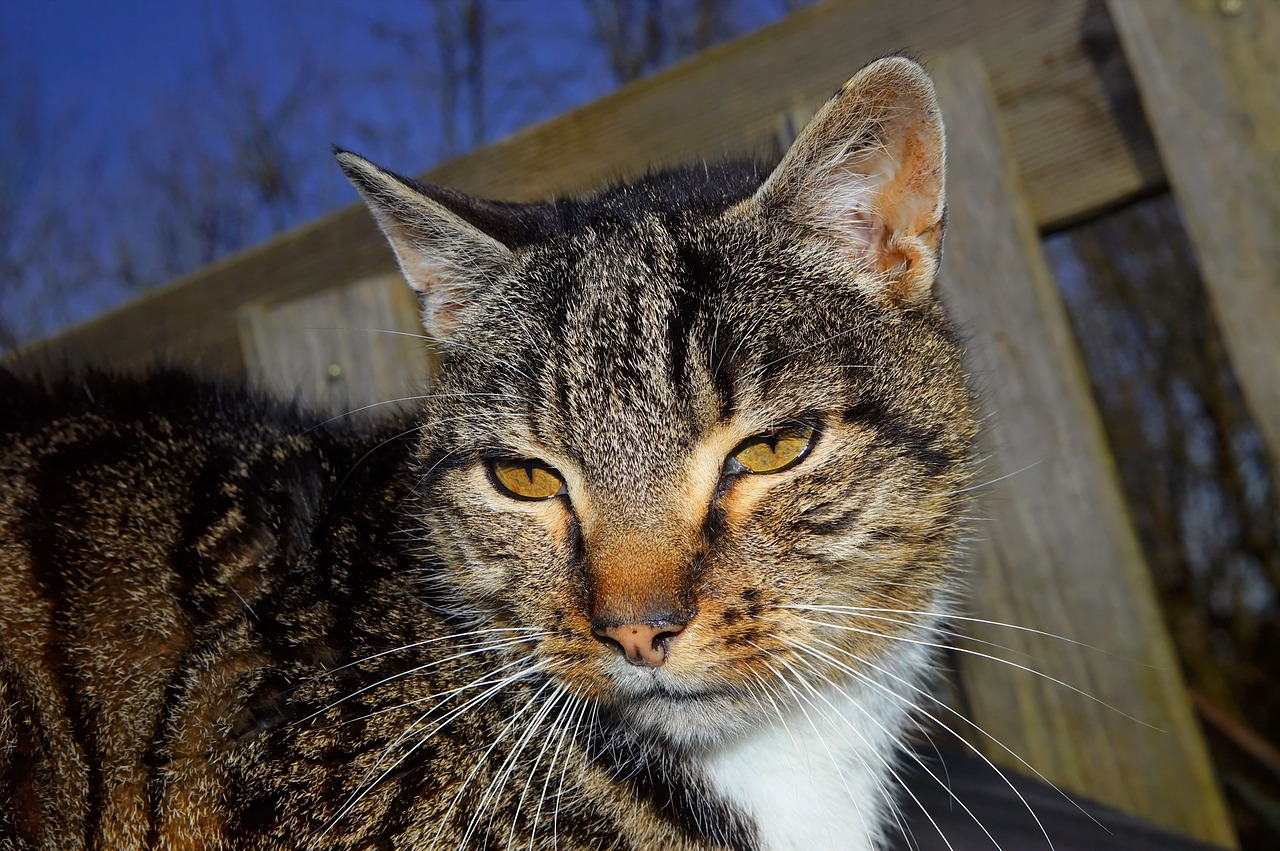
Assistive Devices for Enhanced Mobility
When it comes to our beloved furry friends, their mobility can often become a significant concern as they age. Just like humans, senior pets may experience challenges in movement that can affect their quality of life. Thankfully, there are a variety of assistive devices designed specifically to help these pets regain their independence and comfort. Imagine how a simple tool can transform a pet's daily routine, making it easier for them to navigate their environment and enjoy their golden years!
One of the most popular options is the pet wheelchair. These devices are not just for dogs; they can also be beneficial for senior cats and other small animals. A pet wheelchair provides support for pets with weakened hind legs, allowing them to move around more freely. The joy of watching your pet zoom around again, tail wagging, is priceless! Additionally, many modern wheelchairs are adjustable, ensuring a snug fit as your pet continues to age.
Another fantastic option is slings. These are particularly useful for pets who have difficulty standing up or walking but still retain some mobility. A sling can be used to support your pet’s weight, allowing you to assist them during walks or bathroom breaks. They come in various styles, from simple fabric slings to more structured harnesses, and can be a game-changer for both you and your pet. Just think of it as a helping hand for your furry friend!
For pets that struggle with stairs, ramp systems can be an absolute lifesaver. These ramps can be placed at doorways, in vehicles, or even in your backyard to help your pet access different areas without the strain of jumping or climbing. They come in various sizes and materials, so you can choose one that fits your home and your pet’s needs perfectly. Imagine how much easier it would be for your pet to join you on the couch or in the car without the fear of injury!
Moreover, orthopedic beds can provide much-needed support for senior pets suffering from joint pain or arthritis. These beds are designed to relieve pressure on joints and can significantly enhance your pet’s comfort while resting. Think of it as giving your pet a luxurious hotel experience right at home! With the right bed, your furry companion can enjoy a peaceful night’s sleep, waking up refreshed and ready to take on the day.
As you explore these assistive devices, it’s essential to consider your pet’s unique needs. Not all pets will require the same type of support, so observing their behavior and consulting with your veterinarian can help you make the best choices. In addition, many of these devices can be found in local pet stores or online, making them accessible for pet owners looking to improve their senior pets’ mobility.
In conclusion, assistive devices can significantly enhance the quality of life for senior pets facing mobility challenges. Whether it’s a wheelchair, sling, ramp, or orthopedic bed, investing in these tools can help your furry friend maintain their independence and happiness. Remember, a little support can go a long way in keeping your pet active and engaged during their golden years!
- What should I consider when choosing an assistive device for my pet? It's important to assess your pet's specific needs, size, and mobility limitations. Consulting with your veterinarian can provide valuable insights.
- Are assistive devices safe for all pets? Most assistive devices are designed with safety in mind, but it's crucial to ensure a proper fit and to supervise your pet while using them.
- How can I help my pet adjust to using a wheelchair or sling? Gradual introduction is key. Allow your pet to explore the device in a safe environment, and use positive reinforcement to encourage them.

Managing Pain and Discomfort
When it comes to our beloved senior pets, managing pain and discomfort is a top priority. Just like humans, older animals can experience various types of pain, often due to conditions such as arthritis, hip dysplasia, or even past injuries that resurface over time. Recognizing the signs of pain in pets can sometimes be tricky, as they may not vocalize their discomfort as we do. Instead, you might notice changes in their behavior, such as reluctance to move, difficulty getting up, or even changes in their eating habits. It's essential to be vigilant and attentive to these subtle signs.
So, how can we effectively manage pain and ensure our furry companions lead a comfortable life? First and foremost, consulting with your veterinarian is crucial. They can provide a proper diagnosis and recommend a treatment plan tailored to your pet's specific needs. This plan may include a combination of medications, physical therapy, and even lifestyle changes. For example, non-steroidal anti-inflammatory drugs (NSAIDs) are often prescribed to help alleviate pain and inflammation. However, it's vital to follow your vet's instructions closely, as these medications can have side effects if not administered correctly.
In addition to medication, incorporating natural remedies can also be beneficial. Some pet owners have found success with supplements that support joint health, such as glucosamine and chondroitin. These can help maintain joint function and reduce discomfort. Always discuss these options with your veterinarian to ensure they are safe for your pet.
Moreover, creating a comfortable living environment can significantly impact your pet's overall well-being. Consider the following adjustments:
- Provide soft, supportive bedding to reduce pressure on joints.
- Keep their living space clutter-free to prevent accidents.
- Use ramps or pet stairs to help them reach their favorite spots without straining.
Another effective method for managing pain is through physical therapy and gentle exercise. Engaging your pet in low-impact activities can help maintain their mobility and strength. Swimming, for instance, is an excellent way for dogs to exercise without putting too much strain on their joints. Always consult with a professional who specializes in animal rehabilitation to develop a suitable exercise plan.
Lastly, don't underestimate the power of emotional support. Spending quality time with your pet, providing gentle massages, or even just being present can help alleviate stress and anxiety, which can exacerbate feelings of discomfort. Remember, our pets rely on us to advocate for their health and happiness, especially as they age.
Q: How can I tell if my pet is in pain?
A: Look for signs such as limping, reluctance to move, changes in appetite, or excessive grooming of a specific area. If you notice any of these signs, consult your veterinarian.
Q: Are there safe pain relief options for senior pets?
A: Yes, there are various medications and natural supplements available. Always consult your veterinarian before starting any new treatment.
Q: Can physical therapy help my pet?
A: Absolutely! Physical therapy can improve mobility and reduce pain. A certified animal rehabilitation specialist can provide tailored exercises for your pet.
Q: What home modifications can I make for my senior pet?
A: Consider using non-slip mats, providing ramps or steps, and ensuring their bed is easily accessible to make their environment more comfortable.

Emotional Support and Quality of Life
When it comes to our beloved senior pets, their emotional well-being is just as crucial as their physical health. Imagine your furry friend, once full of energy, now struggling with mobility issues. It can be heartbreaking to witness, and that’s why providing emotional support is vital. Pets, like humans, experience feelings of anxiety, depression, and loneliness, especially when they can’t move around as freely as they used to. So, how can we enhance their quality of life during these challenging times?
First and foremost, creating a calm and comforting environment can make a world of difference. This means establishing a cozy spot where your pet feels safe and secure. Think of it as their little sanctuary. You can use soft bedding, familiar toys, and even your scent to help them feel at ease. Additionally, maintaining a routine can provide a sense of stability for your pet. Just like us, pets thrive on predictability, so try to keep feeding times, walks, and play sessions consistent.
Moreover, engaging in gentle activities can significantly boost their mood. Even if they can’t run or jump like they used to, simple activities such as short walks or interactive play can stimulate their minds and bodies. Consider using toys that encourage mental engagement, like puzzle feeders or treat-dispensing toys. This not only keeps them entertained but also helps in maintaining a healthy weight, which is crucial for their overall well-being.
Another important aspect of emotional support is social interaction. Senior pets may feel isolated, especially if they’re unable to participate in family activities. Make it a point to include them in your daily life. Whether it’s sitting beside you while you watch TV or joining you in the kitchen, your presence can be incredibly reassuring. If you have other pets, monitor their interactions to ensure that your senior pet feels included and not overwhelmed.
Additionally, consider the power of positive reinforcement. Celebrate small victories, whether it’s standing up on their own or taking a few steps. Use treats, praises, or gentle petting to encourage them. This not only boosts their confidence but also strengthens the bond between you and your pet. Remember, your support is their lifeline, and they rely on you to help them navigate this new chapter in their lives.
Lastly, don’t underestimate the importance of professional help. Sometimes, pets may benefit from therapy or counseling, especially if they show signs of severe anxiety or depression. Speak to your veterinarian about options that can provide additional support for your furry friend. After all, it’s about ensuring they live their golden years with dignity, love, and joy.
In summary, providing emotional support to senior pets with mobility issues is a multifaceted approach that involves creating a safe environment, maintaining routines, engaging in gentle activities, ensuring social interaction, and celebrating their achievements. By focusing on their emotional well-being, we can significantly enhance their quality of life, helping them enjoy their time with us to the fullest.
- How can I tell if my senior pet is feeling depressed? Look for changes in behavior, such as decreased appetite, withdrawal from social interactions, or lack of interest in activities they once enjoyed.
- What are some signs my pet is in pain? Signs may include whining, reluctance to move, changes in grooming habits, or unusual aggression.
- How can I help my pet feel more comfortable at home? Create a designated cozy space, maintain a routine, and ensure easy access to their favorite spots.
Frequently Asked Questions
- What are the common signs of mobility issues in senior pets?
Senior pets often show signs of mobility issues through limping, difficulty getting up or lying down, reluctance to jump or climb stairs, and an overall decrease in activity levels. If you notice your furry friend struggling with everyday movements, it’s essential to pay attention and consider a veterinary check-up.
- How often should senior pets visit the veterinarian?
For senior pets, regular veterinary visits are crucial. Ideally, they should see the vet at least twice a year. These check-ups help catch any mobility issues early and allow for timely interventions to keep your pet comfortable and healthy.
- What modifications can I make at home to help my senior pet?
Creating a safe home environment is vital for pets with mobility challenges. Consider adding non-slip mats, ramps for easier access to furniture, and keeping food and water bowls at an accessible height. Also, ensure that their resting areas are cozy and easily reachable.
- How can nutrition impact my senior pet's mobility?
Proper nutrition is key to managing mobility issues. Diets rich in omega-3 fatty acids, glucosamine, and chondroitin can support joint health. Always consult your veterinarian to tailor a diet that meets your pet’s specific needs and helps maintain their mobility.
- What types of physical therapy are available for senior pets?
Physical therapy for senior pets can include exercises, hydrotherapy, and massage. These therapies can enhance strength, flexibility, and overall mobility. Working with a certified pet therapist can provide a customized plan that suits your pet's condition.
- Are there assistive devices that can help my pet?
Yes! There are various assistive devices available, such as harnesses, slings, and orthopedic beds. These tools can significantly improve your pet's mobility and comfort, making everyday activities easier for them.
- What options do I have for managing my pet's pain?
Managing pain in senior pets can involve medications prescribed by your veterinarian, such as anti-inflammatories or pain relievers. Additionally, alternative therapies like acupuncture or laser therapy can be beneficial in alleviating discomfort.
- How can I provide emotional support to my senior pet?
Emotional support is just as important as physical care. Spend quality time with your pet, engage in gentle play, and provide a calm environment. Simple acts like cuddling or talking to them can greatly enhance their emotional well-being.




